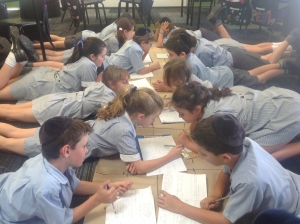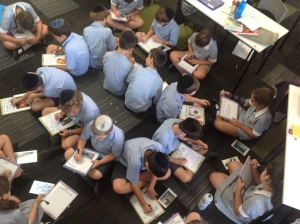Last week a collague asked me, “Why do you think you have changed?” She was inquiring into the reasons for my change in my attitude and approach to learning, not doubting that I had changed 🙂
In my last post I reflected on how I had changed (in my teaching practice) and how my students had changed and the connections between the two. But my colleague’s question really got me thinking about how and why I have changed/ grown. I have thought about this for nearly a week…
I no longer feel I have to be in control or be the expert, instead I have taken ownership of my learning…
This may seem like a contradiction but, simply put, I am owning my learning – I consciously take on board the new learning and I consciously decide how I will manage that new learning. I realise I have changed significantly in the way I approach new learning and this change has impacted on my attitude to trying new ways of learning with my students. Up until about a year ago, when I was presented with a new resource or new program or new web tool we were going to learn to use in our teaching, my default setting most of the time was to panic about the time required to become knowledgeable and the time required to implement it properly. I would then feel frustrated that I was being forced to learn something new when I was still trying to embed recently acquired knowledge or skills.
I don’t panic anymore. I am comfortable with just exploring and seeing what I learn, see what others learn. I am comfortable with not having to do something exactly as presented. I am comfortable with adapting it to meet the needs of my students or my own. I am comfortable with letting things percolate until I’m ready.
Guiding questions for my learning…
Another factor contributing to my change, I think, is because I am now approaching new learning using the key questions, “What am I doing?” and “Why am I doing it?” I learned to think this way because of the explicit discussions my class and I have around these two questions this year.
I have always asked these questions but because I have let go of the need to be in control or be the expert, I approach new learning with a curious attitude and an open mind. I try and enjoy it for what it is.
What this has made me realise about my learners…
I’m not sure that I’ve been articulating my thoughts well, but the point of this reflection is this: I have been trying to encourage my students to become authentic, reflective learners who want to take ownership of their learning. (I have written a few posts about my attempts). BUT it’s just hit me that they may be resisting learning sometimes because…
*they feel the panic I used to feel because they feel pressured by a lack of time,
*or they may not be ready, or interested in what I am presenting them with at the time.
* or I haven’t given them control of their learning – (I’m not 100% comfortable with doing this yet because I’m still learning how to)
* or they may feel frustrated because I am limiting them with my expectations
* or I am not appealing to their learning style.
If I want my students to take ownership of their learning then I need to be mindful of how they may be feeling about their learning. I also need to question whether what we are doing and how we are doing it is setting them up to take ownership of their learning.
Which brings me to the other stuff…
Last term my class and I regularly considered our learning. One discussion really stands out for me. I had asked them, “When you are learning about something, what else are you learning?” I then gave them a few examples to make my question clearer. For example, when you are learning how to draw a graph, or learning how to do something with a group, what else are you learning?
After a few hits and misses, they got what I was referring to. One student suggested we refer to the two types of learning as formal and informal learning.
This is what they thought…
Formal learning is: the content or the task, what the teacher is trying to teach, what the students are working on.
Informal learning is: the other stuff, learning to work collaboratively, learning to solve a problem, learning to use technology, getting better at making decisions, learning to take turns, learning to communicate, learning to take risks, being on task and most importantly, who owns the learning.
As a result of days of reflecting about why I had changed, I have realised that I need to ensure that the “other stuff” my students are learning, doesn’t contradict or undermine our goal for them to take ownership of their learning!!!



